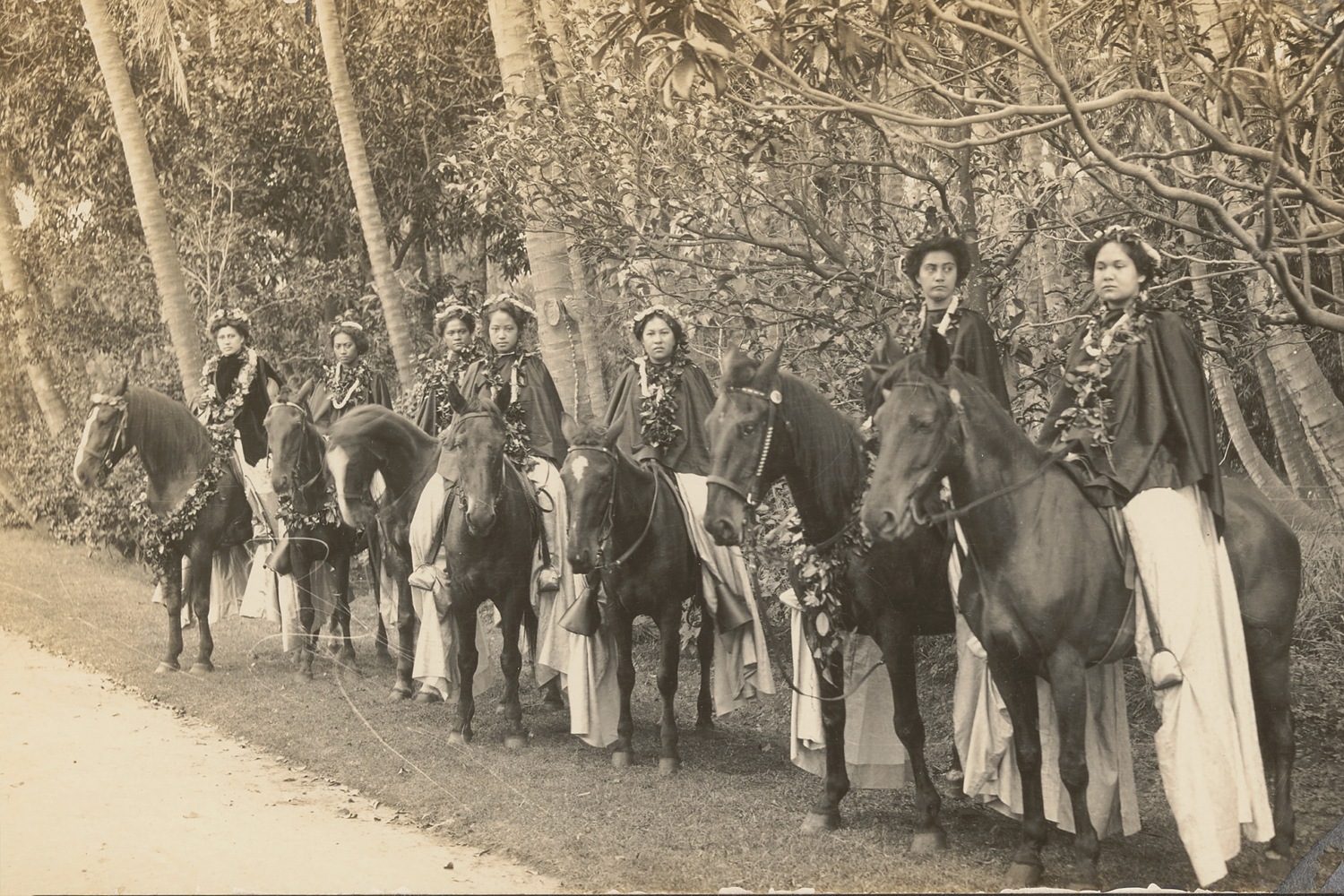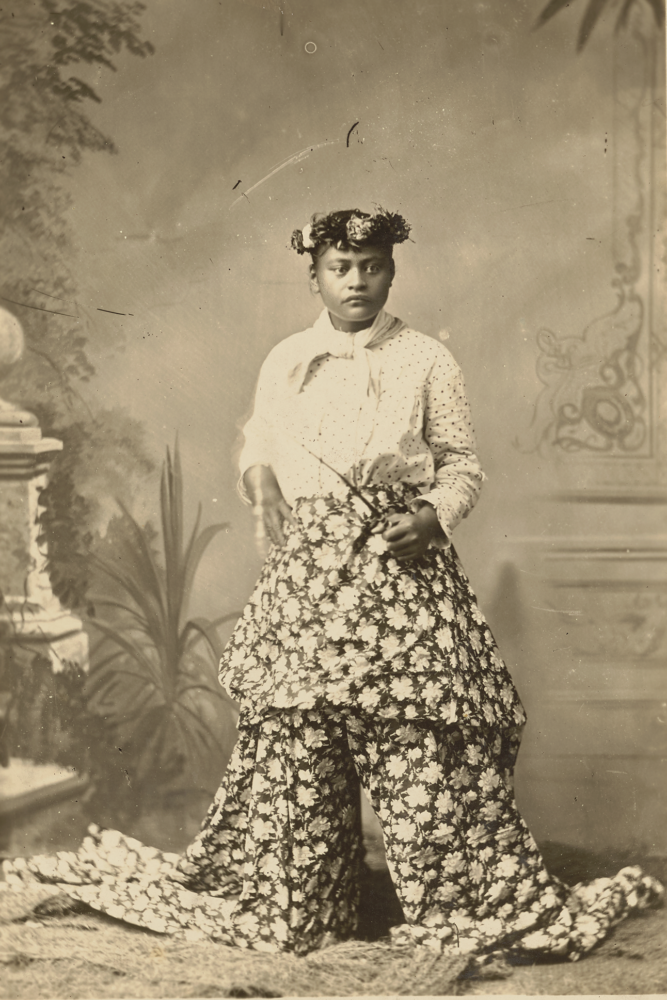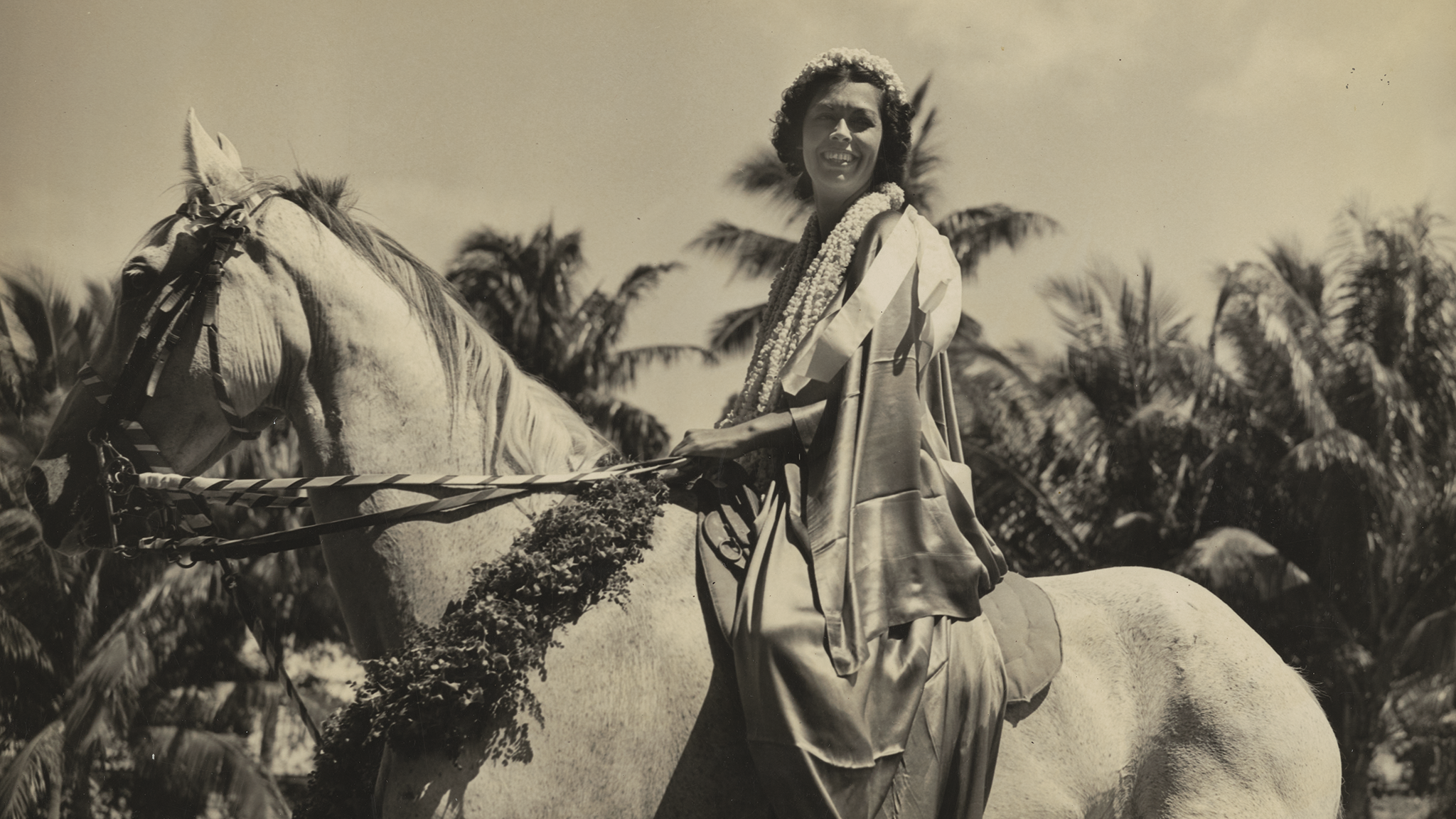In old Hawaiʻi, the bold horsewomen who popularized the style captured the popular imagination.
First came the beating of horse hooves. The cacophony of half a dozen steeds at full gallop reverberated over the thrum of newly arrived steam ships and crowds of disembarking tourists and harbor merchants hawking their wares. Then, a whirwind of color: silks in scarlet, orange, and white bedecked the riders, as if they were set ablaze in the midday sun.
The riders were congregated in downtown Honolulu for steamer day, when steam ships docked at Honolulu harbor to let off their passengers. Spectated by throngs of visitors and locals alike, their cavalcade charged through the city’s uneven avenues, racing one another at two or even three riders abreast. Their long riding skirts billowed behind them, whipping in the wind with their unbound hair and garlands of fresh lei.
During that time, horsemanship was considered the sole dominion of men. There were the American cowboys and their vaquero predecessors. There were the rodeomen, the ranch hands. In Hawai‘i, the term paniolo conjured images of commanding men atop their steeds. And yet, none of the riders racing that day were men.
They were pāʻū riders, named after the unique riding skirts that became their trademark. They came to prominence in the 19th century, after the introduction of horses to Hawai‘i in 1803 made horseback riding the islands’ primary mode of transportation.

Pāʻū riders are named after the unique riding skirts that became their trademark. They came to prominence after the introduction of horses to Hawaiʻi in 1803. Image from Hawai‘i State Archives.
It wasn’t just their penchant for street races that made Hawai‘i’s female riders distinct from their European and American counterparts. They eschewed the sidesaddle, a Western method of riding meant to keep women modest, but which only succeeded in making the act more cumbersome. Instead, they rode astride. “The European style of riding sidesaddle did not appeal to the Hawaiian women, who felt this method too unstable when riding over the islands’ rough terrain,” wrote Virginia Cowan Smith and Bonnie Domrose Stone in their 1995 book, Aloha Cowboy.
With this riding style came a quandry, however. The popular dress of the day, with its full, floor-length skirts, made riding astride uncomfortable; women’s trousers weren’t socially acceptable until the late 1800s. Enter the pāʻū skirt. Up to 25 yards of fabric were wrapped and folded to form a flowing, culotte-style garment acted as a riding habit, fastened atop the outfit — often times a holokū — to protect it from the dust, sweat, and rain while on horseback and taken off upon arrival at the social function.
We never had a damsel in distress in Hawai‘i. Women in Hawai‘i held a lot of power — more freedom than their American or European counterparts. If a woman in old Hawai‘i wanted to put on her pāʻū and gallop, she would just tell her husband and that would be the end of the discussion.
Kimo Alama Keaulana, pāʻū draper
At first, the pāʻū was simple, the fabric choices modest. They were manufactured from tapa, a material made from the inner bark of paper mulberry trees, soaked in kamani oil to render it waterproof. Later, imported fabrics like cotton, calico, and gingham were favored for their sturdiness. The skirt was treated much like how we use raincoats today, a garment of pure practicality.
That changed as horses became more accessible and riding them became a form of leisurely recreation. Riding parties, groups of men and women on horseback touring through the countryside, were popularized by Hawai‘i’s monarchy. There was the Hui Holo Lio a Lili‘uokalani, led by Queen Lili‘uokalani when she was still a princess, and Prince Jonah Kuhiō Kalaniana‘ole’s beloved riding club, immortalized in mele. On these hours-long excursions, the pāʻū was more than a shield protecting the outfit underneath. The pāʻū was the outfit.

Pā‘ū riding is a testament to Hawaiian splendor and style with fabrics ranging from simple to flamboyant. Today’s parades are a meaningful endeavor for modern riders, carrying the same gravitas as prestigious hula events.
Simple fabrics gave way to the ornate. Yards of satin and silk in striking colors were folded in various styles, bustles and pleats fastened into place with kukui nuts by expert pāʻū drapers. “That must have been such a beautiful sight to see all the different printed pāʻū and the leis they made to show off,” says Kimo Alama Keaulana, a modern-day pāʻū draper.
By the late 1800s, the pāʻū rider was a common sight in both town and country. For Western observers, she may have signified liberation — an eschewing of patriarchal customs, an act of revolt not unlike that of Lady Godiva. Here was a woman, untethered to a man, riding free in the streets.
In reality, Keaulana says, pāʻū riders were not resisting anything. They were simply Hawai‘i women enjoying themselves. “We never had a damsel in distress in Hawai‘i,” Keaulana says. “Women in Hawai‘i held a lot of power — more freedom than their American or European counterparts. If a woman in old Hawai‘i wanted to put on her pāʻū and gallop, she would just tell her husband and that would be the end of the discussion.”
But the age of the pāʻū rider soon came to an end. At the turn of the 20th century, motorized transportation took over Hawai‘i’s roads. Horseback riding through Honolulu’s streets was outlawed to keep them clear for cars and trams. “The Pāʻū Skirt — R.I.P.,” declared a headline in the Paradise of the Pacific.
Pāʻū riders would have quickly become a relic of old Hawai‘i if not for the parades. In 1905, a socialite by the name of Lizzie Pauahi organized a group of 40 horsewomen to ride pāʻū style in a floral parade. A year later, Theresa Wilcox formed a second group of riders who began exhibition riding in colorful pāʻū attire. Soon, the pāʻū rider was a regular fixture in local parades. Women of high society — like Princess Lydia Lili‘uokalani Kawānanakoa, a descendant of the Hawaiian monarchy — commonly rode in parades in pāʻū.

“Women in Hawai‘i held a lot of power—more freedom than their American or European counterparts. If a woman in old Hawai‘i wanted to put on her pāʻū and gallop, she would just tell her husband and that would be the end of the discussion,” says pāʻū draper Kimo Alama.
Today, the tradition continues with annual events like the Aloha Week Parade and the Kamehameha Day Parade, with each island represented by a princess and her accompanying pages. At the head is the pāʻū queen, the highest honor bestowed upon a pāʻū rider.
The parades are a meaningful endeavor for modern pā‘ū riders, embodying the same gravitas as the Merrie Monarch Festival does for hula dancers. Preparations are a costly, months-long affair. “When people see a pāʻū unit in the parade, they don’t know how much time and resources it takes to put those two or three minutes in front of their eyes,” says Keaulana, who has for decades acted as the official pāʻū draper for the Kamehameha Day Parade.
“I’ve trained my daughters since the age of three,” says Leiala Cook, who heads Hawai‘i Pāʻū Riders, “just like how my mother did for me.” Pāʻū riding is often multi-generational, with horsewomen like Cook training their daughters from a young age. In 2010, Cook became one of the youngest pāʻū queens to ride in the King Kamehameha Day Parade. She hopes that her eldest daughter, Heavenly, will one day receive the same honor. “That really makes me feel fulfilled,” she says. “It’s legacy that’s being handed down.”
From its spirited origins to the present day, pāʻū riding is an enduring testament to Hawaiian showmanship and style. “I always tell people without pāʻū riders, you don’t have a Hawaiian parade. You just have a parade,” Keaulana says. “This is what makes Hawai‘i nowhere else in the world. And that’s important to me — to keep a sense of place here in Hawaiʻi.”

